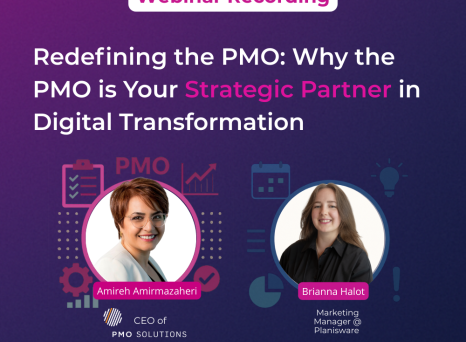A project management office (PMO) is an organizational structure dedicated to establishing and maintaining project management standards, processes, and best practices.
There’s no template for building one. This is a good thing.
After all, different companies will have different goals, different infrastructures, and different methodologies. A singular framework that answers everyone’s needs is simply a fallacy.
This means you have the freedom and flexibility to create a PMO that suits your circumstances and objectives, and should you ever need to shift focus, to pivot and change direction.
To guide you in choosing a PMO organizational structure best suited to your business, there are three preeminent models popularly cited by thought leaders and professional organizations.
These are defined in the PMI’s Project Management Book Of Knowledge—a set of standard terminology and guidelines for project management. Let’s explore each model and add a little additional context.
What are the 3 main types of PMO structure?
The three most commonly cited PMO structures are supportive, controlling, and directive. The supportive PMO offers guidance and best practices, the controlling PMO enforces standards and ensures compliance, while directive PMOs take active ownership of projects and resources.
1. The supportive PMO: Provides guidance and best practices
The supportive PMO provides support, resources, and best practices to project teams, but does not enforce compliance or directly manage them. It’s a non-invasive and flexible model that does the following:
- Centralizes ownership of processes, tools and capacities
- Provides and develops materials, tools, and templates
- Enables data access and enhances data quality through post-review controlling
- Provides on-demand support for projects
- Provides analysis and governance
- Develops and maintains the PMO’s capabilities
This type of PMO provides a consultative role to projects and is a good fit for organizations with low “maturity.” This refers to the sophistication, standardization, and integration of an organization’s project management processes.
We’ve written a short guide on how to assess your project management maturity level. Some signs of low maturity are a lack of developed processes and strategies and reliance on individual efforts and skills.
A supportive PMO may be a great fit for organizations who would benefit from a centralized knowledge hub, but who do not have the need for high levels of control. This model encourages autonomy and innovation—great when you have skilled and experienced project managers and no desire for the PMO to control outcomes.
This model is quite common in creative industries, education, marketing, and early-stage startups. Essentially, wherever flexibility and light-touch guidance (not strict oversight) is desired, a supportive PMO is a natural fit.
A supportive PMO real-world example
A great case study in the supportive PMO is Fannie Mae. This financing company for housing lenders was only eight years old when it won PMI’s PMO of the year. The focus of their Enterprise PMO (EPMO) was to continuously mature program governance—that is, centralizing best practices, investing in tools, and evolving processes.
As such, they were able to support their company’s strategic vision. They grew from simply managing projects to running strategically-aligned programs and portfolios.
2. The controlling PMO: Governs processes and ensures compliance
The controlling PMO, also known as the administrative model, focuses on enforcing project management standards to ensure consistency and strategic alignment.
Like the supportive PMO, this type provides support, but it goes further by requiring compliance through various means, such as mandatory use of templates, formal project reviews, and regular reporting.
The controlling model does the following:
- Centralizes ownership of process and tools
- Provides and develops materials, tools, and templates
- Enables data access
- Exercises basic control of the data and its processes
- Provides basic support for projects
- Maintains analysis capabilities
- Maintains critical PMO capabilities
The enforcement of standards is what separates the controlling from the supportive PMO. It is suited to organizations with moderate levels of project management maturity—a supportive PMO model may already be in place.
The controlling PMO is widely adopted in industries where compliance, documentation, and risk management are key, but some flexibility in project management is still required. This can include healthcare, manufacturing, finance, and government.
It offers greater consistency across processes, which can improve tracking, reporting and quality control, but without full centralization.
A controlling PMO real-world example
Let’s look at Intel’s IT PMO as an example of a controlling organizational structure. Before they implemented their IT PMO, deadlines were frequently missed and projects pushed into the next quarter. Their model does the following:
- Sets standards for project deliverables, including tracking and communicating schedules
- Sets measurable delivery goals and milestones
- Performs stage-gate reviews
- Conducts quality measures
However—and this point is key to a controlling model—it still gives project teams the flexibility to determine which processes they need, and which they don’t.
“Having a standardized project management framework creates consistency while giving them the flexibility to engineer the deliverables of the project life cycle however they’d like.”
— Mark Brodnik, Intel program/project manager
Through implementing this IT PMO, Intel steadily increased the number of projects they released, all without breaking the budget.
3. The directive PMO: Actively manages projects and resources
The directive PMO has the highest level of involvement in projects. It directs all phases of project delivery—planning, execution, and monitoring—and is fully accountable for outcomes.
Unlike the supportive and controlling PMOs, which offer guidance and enforce standards, the direct PMO runs projects. Project managers are assigned from the PMO and report directly back to it, giving a high level of consistency of practice.
This level of direct control is achieved by:
- Centralizing ownership of process and tools
- Managing project execution and evolution
- Maintaining and developing tools
- Ensuring data quality and accuracy
- Providing hands-on support and expertise
- Providing analysis to guide decision making
- Organizing and supporting governance
- Developing and maintaining PMO capabilities
- Supporting delivery with dedicated teams
A directive PMO is suited to industries where control, risk mitigation, and regulatory compliance are essential, like aerospace and defense, construction, energy, and pharmaceuticals.
Projects can be complex and heavily regulated, demanding the strong oversight, accountability, and coordination offered only by this model of PMO.
A directive PMO real-world example
Take Suncorp Metway Ltd. as a success story in the implementation of the directive PMO. This Australian financial services company developed its Strategic Building Blocks Program (SBBP) to ensure every project delivered business benefits. Achieving this required a high level of project management discipline and capabilities.
To that end, the SBBP created a strong governance framework around costs, benefits, and delivery management. This structure enabled close monitoring of progress and metrics throughout the project lifecycle to ensure teams delivered the expected outcomes.
Crucially, the program also required that business units make a business case for every project and take ownership of the results.
“It’s clear to everyone what is expected and that every project will be seen as a business improvement act.”
— Adrian McKnight, PMP, SBBP program director
When the SBBP undertook a project to deliver a system that would improve home and motor insurance claims, they turned to their project management methodologies. Specifically, the team broke the project into smaller deliverables for the client, which helped the client become more invested in the project.
A project retrospective confirmed the impact: higher client satisfaction, a more user-friendly system, and a significant reduction in claims handling costs.
How to choose the right PMO type and organizational structure
From reading the definitions, you’ll no doubt already have a sense for what type of PMO is best suited to your organization. It all comes down to industry, project management ecosystem maturity, and PMO control requirements.
Industry
In areas like education and marketing, light-touch guidance and flexibility are key, making the supportive PMO the natural choice. In heavily regulated sectors like aerospace and defense, only the directive PMO can achieve the required level of consistency and quality assurance.
Project management ecosystem maturity
If your organization has ad-hoc practices and thrives through individual heroics, a supportive PMO can introduce some structure without being overbearing or cumbersome. If you’re already using standardized tools and templates, a controlling PMO may be appropriate.
PMO control requirements
If your teams are autonomous and self-sufficient, anything more than a supportive PMO can be unnecessarily intrusive. If your projects require consistent delivery and close oversight, they lend themselves to the controlling or directive model.
But know, whatever type you do choose, it’s not gospel. Analyze your results. If it doesn’t align with your business objectives you can course-correct and find a model that fits your mold.
You might find our e-book on determining the right PMO fit for your organization useful.
Transitioning between different types of PMO
Over time, projects can become more complex, regulatory requirements can change, and strategic alignment can become more important. The evolution from a controlling to a directive PMO is a natural progression for many organizations.
An example may be a mid-sized medical devices organization launching a range of global products. In the face of more regulation, project delivery becomes more complex and risky. A move to a directive PMO can help to plug documentation gaps and ensure consistency in project delivery timelines.
Different ways of looking at PMO type and structure
While the supportive, controlling, and directive are by far the most popular types of PMO, the nice thing about the PMO is that its execution is highly flexible. There’s no need to pigeonhole yourself into one type.
In fact, there are several other different ways to look at structure. For example, the PMI (Project Management Institute) identifies five separate models:
- Organizational PMO: Provides project-related services to support a strategic business unit.
- Project support services: Provides processes to support the management of project, program, or portfolio work.
- Enterprise PMO: Provides alignment of project and program work to organizational strategy.
- Center of Excellence: Provides an organization with standards, methodologies, and tools to support project work.
- Project-specific PMO: Provides project-related services on a temporary basis to support a specific project or program.
Then there’s Gartner, one of the main analysts in the project management space. Because their focus is on IT, they’re less concerned with PMOs that deal with non-IT projects (such as the R&D or enterprise PMO). They define PMOs using the following four categories:
- The activist PMO: Takes a broad view, instead of a controlling approach. It supports decision makers by analyzing business cases for alignment and risk.
- The delivery PMO: Plans and controls the execution of projects to business expectations. Also known as the project delivery PMO.
- The compliance PMO: Establishes standard practices for measuring project performance. It also develops an understanding of key initiatives.
- The centralized PMO: Enables representatives from various project support organizations to share best practices. As such, it fosters faster onboarding for new project management hires.
Drive your PMO to greater maturity with Planisware
Whatever stage your PMO is at, Planisware can scale with your organization and take your processes to the next level.
From strategic planning to project execution and everything in between, our strategic project and portfolio management solutions boast a range of world-class capabilities and features for unlocking greater PMO maturity.
Book a one-to-one demo today and see Planisware in action.


